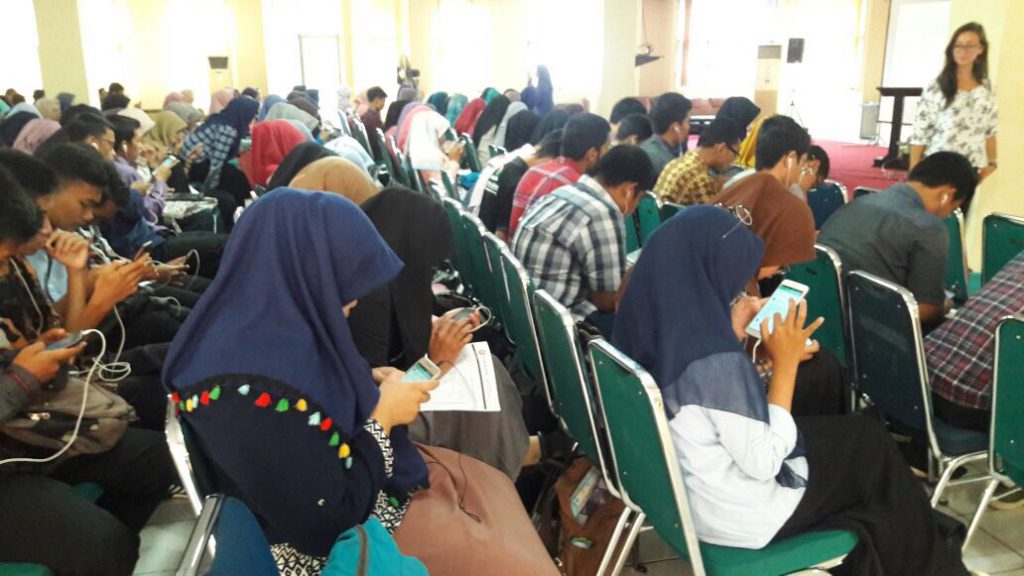Online and offline
For many students internet access is no more than a dream. At Clarity, we still provide CD-ROMS to remote schools in Afghanistan and Ethiopia, and to learning communities which can’t go online for security reasons, such as correctional facilities or naval installations. For other groups, internet connections may be intermittent, unreliable, or simply weak. Most people have unstable internet at home.
Back in 2015 when we first visualised what the Dynamic Placement Test might look like, one guiding principle was that it had to be democratic: these groups had to be catered to; it was not going to be a test restricted to those with high-speed broadband. This meant building it with both online and offline modes.
What does this mean in practice? In essence, if you have a good internet connection, you can run it online and the test items and media will download as they are required. But if you don’t have a good connection, you can download the whole thing in advance and it will run with no internet connection at all, uploading results for the administrator to see in the Admin Panel the next time you connect. Let’s look at a couple of scenarios, and then move on to some practicalities.
Scenario 1: Good internet connection
Example: Testing at Universitas Indonesia
If your internet connection is robust, it is better to opt for the default online mode. This means that students do not have to remember to download the test in advance, and it means a smaller overall download (offline mode requires a download of all items from A1 to C2, whereas online mode only downloads what is required for a given student’s test path). Note that even if there is an unexpected internet outage, test takers will be able to continue as soon as the connection is re-established. They will not have to start again from the beginning, and data will not be lost.
Scenario 2: Testing students at home
Example: Brunel University in China
Much is made of the Great Firewall of China, but at Clarity we have not found that it has an impact on our delivery of testing and learning materials. In this case, however, there were other factors at work. Brunel University Admissions required students to take the test at home in the evening. This was during the lockdown, so there was exceptionally high internet usage in the apartment blocks: some people were working from home, others were binge watching movies. The quality of connections was therefore difficult to gauge, so it was safer to choose offline mode.
This means that students must download the test in advance. The download is about 33.6MB, a little less than the average iOS app file size (34.3MB in January 2020), so by no means large. The download can be done at a time of lower internet traffic, in a coffee shop, library, or anywhere else that the student can get wifi or data. In the case of naval installations or prisons, devices can be prepared offsite.
As soon as the download is complete, it is ready to go and no further action is required. The test will go live at the time specified by the Administrator in the Admin Panel setup. The test taker can leave their WiFi connection on, or turn it off: the internet now plays no part in the test until the upload of the final result. This will happen either immediately (if the device is connected) or as soon as a connection is re-established.
Practical details
Organising offline mode download
If you have a large number of students doing the test together and you choose offline mode, it is essential that they download the test in advance. In this case at Wenzao University, “offline mode was mistakenly chosen which meant that with hundreds of students all starting a large download at the same time the system became slow.” Clearly, 500 test takers all starting a 30MB download at the same time is going to challenge the most robust of systems. It is therefore best not to let students into the room until they can show you the “test ready” screen on their device.
Setting the welcome email to offline mode
When you set up the test in the Admin Panel, the default welcome email points test takers to the online mode test link (https://dpt.clarityenglish.com/). Click on Edit, top right, and you will see a second template, the offline mode welcome email. This points test takers to a different URL: https://dpt.clarityenglish.com/#offline
Keeping the test in the browser
What happens if you download the test and you accidentally close the browser, or your device runs out of battery? The test is cached in the browser, so you simply need to go back to the Dynamic Placement Test URL and it will reappear.
What happens to the download afterwards?
The default setting of browsers supported by the Dynamic Placement Test is to periodically clear unwanted items from the cache. Under this setting, the test download will simply disappear.
Using Access Codes to control start time
As stated above, you can set the start time for the test in the Admin Panel setup screen. But what if you want more control? If you are invigilating the test in a computer room or lecture theatre, you can prevent test takers from starting even after the test has gone live by setting an Access Code. This is also done on the test setup screen, and once it is set, the test cannot be accessed until the code is entered. When you are ready, simply write the Access Code on the whiteboard for test takers to copy in on their device, and they can start the test.
Further reading:
A world in lockdown: adapting to remote testing
Running tests from home

